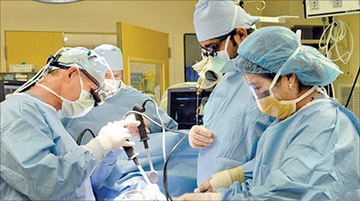The man with a plastic heart
19 February BBC
Heart disease threatens the lives of millions, but with only limited
hearts available for transplant, medical science has long yearned for a
definitive fix to repair or replace this most vital organ.
 Troy Golden, a pastor from Oklahoma, was born with a heart that would
one day break. A genetic condition known as Marfan's syndrome has been
slowly attacking his body tissue since birth including around his heart
and valves. Troy Golden, a pastor from Oklahoma, was born with a heart that would
one day break. A genetic condition known as Marfan's syndrome has been
slowly attacking his body tissue since birth including around his heart
and valves.
At the age of 41, he had to undergo life-saving surgery, replacing
valves and reshaping his heart's walls. But his condition continued to
worsen. In January 2010, he was put on the heart transplant list, but
time ran out without a donor.
"Troy's heart was so bad that a traditional heart pump wouldn't be
enough," explains Troy's cardiologist Dr Doug Horstmanshof. "So, we
decided to try something different - completely replacing the heart."
In September last year, Troy became one of the few people in the US
to have his entire heart replaced with a device called the Total
Artificial Heart. It's made of plastic and weighs 160 grams and is a
little larger than a biological heart. It is powered by a pneumatic pump
that you carry around in a rucksack.
Awe inspiring moment Dr James Long, Troy's surgeon, recalled the
moment the heart was implanted into Troy. "It was admittedly rather
awe-inspiring," he says. And it was ominous to look inside the chest and
know that the only thing keeping him alive was the synthetic pump that
we had just replaced his heart with."
Troy has had to get used to the non-stop sound of the pneumatic pump.
But he looks and feels remarkably well and is overwhelmed by what has
been done for him.
"It's awesome," he said "to be out of the hospital and to be able to
come back home and to be able to come back to some normal life."
"You can't even just really comprehend taking your heart out, you
know, without a heart you're not alive."
The Total Artificial Heart has done more than buy Troy some time. It
has given him his life back and it has given him hope. But this is not a
permanent solution. His heart's batteries must be constantly charged,
spares must stand at the ready. The risk of infection and clotting add
to the constant worry.
Medical challenge For now Troy must again endure the long wait for a
donor heart, but there are other solutions on the horizon. New avenues
of research are focusing on efforts to assist, rather than replace the
heart.
Increasingly, in patients suffering from heart failure, miniaturised
pumps are being used to assist heart function. They are about the size
of a cigar and are essentially plugged into the main pumping chamber of
the heart to help it along.
Unlike Troy's artificial heart, they can be left in place
indefinitely. But perhaps more remarkable is the fact that these pumps
can sometime be removed, once a damaged heart has recovered.
And it is the potential for hearts to actually recover, after having
been damaged, that is being investigated in some of the most exciting
research going on today.
Much interest centres on stem cells because they are the closest
natural thing to the body' s spare parts and, under the right
conditions, they have the potential to transform into a huge number of
different cell types with specialised functions. Because of this, they
can take part in the process of renewal - replacing diseased and damaged
tissues.
Preliminary results are highly controversial, but there is a growing
body of evidence that suggests we may in the future be able to harness
the heart's potential regenerative capacity for future therapies.
Growing new hearts More radically, Dr Doris Taylor, of the University
of Minnesota, has been using stem cells to actually build new hearts in
the laboratory.
She has achieved this with a rat heart by stripping it of its cells,
then re-populating the resulting perfectly heart-shaped scaffold with
stem cells, which adapt into heart tissue, so that in time the heart
begins to beat again.
".. the thought would be that we would take a heart, probably from a
pig .. wash all the cells out, and then take your cells and grow enough
of them to .. build a heart that matches your body and have it
transplanted into you. That's the home run," says Dr Taylor.
If the clinical application can be made to work, it is a
revolutionary if relatively distant possibility.
For Troy and the millions of people like him for whom heart failure
is a reality, this work is of vital importance.
There is the very real possibility here that, within our lifetimes,
scientists might finally find the cure they're looking for.
While their search for that magic bullet remedy is far from at an
end, each new discovery brings them another step closer.
|

